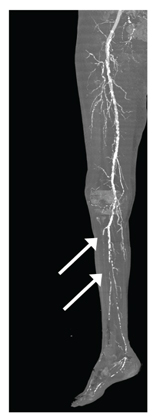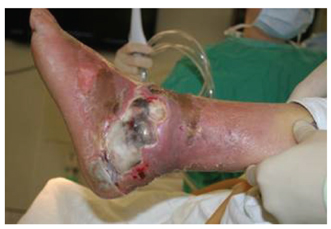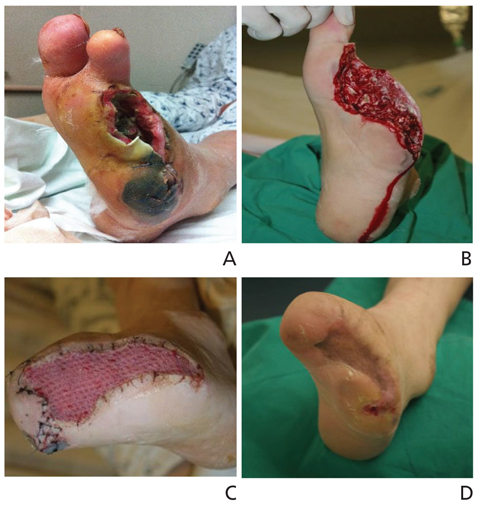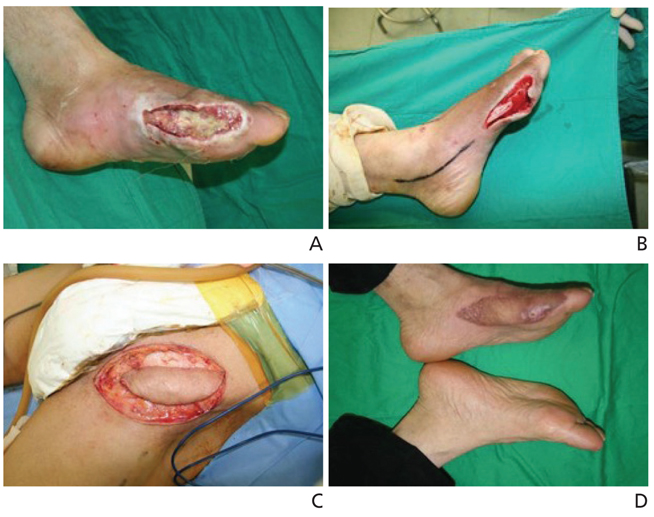J Korean Med Assoc.
2015 Sep;58(9):795-800. 10.5124/jkma.2015.58.9.795.
Diabetic foot ulcer
- Affiliations
-
- 1Department of Plastic Surgery, Asan Medical Center, University of Ulsan College of Medicine, Seoul, Korea. joonphong@amc.seoul.kr
- KMID: 2195091
- DOI: http://doi.org/10.5124/jkma.2015.58.9.795
Abstract
- The clinical significance of diabetes is increasing with a growing aged population and changes in lifestyle. Among all complications of diabetes mellitus, diabetic ulcers are the most severe and expensive. The lifetime incidence of diabetic foot ulceration is as high as 25%. Ulcers frequently become infected and are associated with the risk of limb amputation and increased mortality and healthcare costs. A specialized multidisciplinary team approach is needed to care for patients with ulceration. Comorbidities such as poor limb circulation and the loss of protective sensation due to diabetic vasculopathy and neuropathy should be treated concurrently to promote wound healing. In cases of ischemia, transluminal angioplasty or bypass surgery may enhance circulation, allowing ulcer healing or reconstructive surgery. With an integrated team approach, the major focus of ulcer treatment has changed from amputation to limb salvage. Appropriate follow-up, including the minimization of risk factors and education on foot care in daily living, is essential to prevent re-ulceration.
Keyword
MeSH Terms
Figure
Cited by 1 articles
-
Chronic wound
Jong Won Rhie
J Korean Med Assoc. 2015;58(9):784-785. doi: 10.5124/jkma.2015.58.9.784.
Reference
-
1. Wild S, Roglic G, Green A, Sicree R, King H. Global prevalence of diabetes: estimates for the year 2000 and projections for 2030. Diabetes Care. 2004; 27:1047–1053.
Article2. Guariguata L, Whiting DR, Hambleton I, Beagley J, Linnenkamp U, Shaw JE. Global estimates of diabetes prevalence for 2013 and projections for 2035. Diabetes Res Clin Pract. 2014; 103:137–149.
Article3. Ahn KJ. Epidemiology of diabetic foot disease. J Korean Diabetes. 2011; 12:72–75.
Article4. Boulton AJ, Vileikyte L, Ragnarson-Tennvall G, Apelqvist J. The global burden of diabetic foot disease. Lancet. 2005; 366:1719–1724.
Article5. Abbott CA, Carrington AL, Ashe H, Bath S, Every LC, Griffiths J, Hann AW, Hussein A, Jackson N, Johnson KE, Ryder CH, Torkington R, Van Ross ER, Whalley AM, Widdows P, Williamson S, Boulton AJ. North-West Diabetes Foot Care Study. The North-West Diabetes Foot Care Study: incidence of, and risk factors for, new diabetic foot ulceration in a community-based patient cohort. Diabet Med. 2002; 19:377–384.
Article6. Singh N, Armstrong DG, Lipsky BA. Preventing foot ulcers in patients with diabetes. JAMA. 2005; 293:217–228.
Article7. Boulton AJ, Kirsner RS, Vileikyte L. Clinical practice: neuropathic diabetic foot ulcers. N Engl J Med. 2004; 351:48–55.8. Abbott CA, Vileikyte L, Williamson S, Carrington AL, Boulton AJ. Multicenter study of the incidence of and predictive risk factors for diabetic neuropathic foot ulceration. Diabetes Care. 1998; 21:1071–1075.
Article9. Lavery LA, Armstrong DG, Vela SA, Quebedeaux TL, Fleischli JG. Practical criteria for screening patients at high risk for diabetic foot ulceration. Arch Intern Med. 1998; 158:157–162.
Article10. Prompers L, Huijberts M, Apelqvist J, Jude E, Piaggesi A, Bakker K, Edmonds M, Holstein P, Jirkovska A, Mauricio D, Ragnarson Tennvall G, Reike H, Spraul M, Uccioli L, Urbancic V, Van Acker K, van Baal J, van Merode F, Schaper N. High prevalence of ischaemia, infection and serious comorbidity in patients with diabetic foot disease in Europe: baseline results from the Eurodiale study. Diabetologia. 2007; 50:18–25.
Article11. Eskelinen E, Lepantalo M, Hietala EM, Sell H, Kauppila L, Maenpaa I, Pitkanen J, Salminen-Peltola P, Leutola S, Eskelinen A, Kivioja A, Tukiainen E, Lukinmaa A, Brasken P, Railo M. Lower limb amputations in Southern Finland in 2000 and trends up to 2001. Eur J Vasc Endovasc Surg. 2004; 27:193–200.
Article12. McDermott MM, Greenland P, Liu K, Guralnik JM, Celic L, Criqui MH, Chan C, Martin GJ, Schneider J, Pearce WH, Taylor LM, Clark E. The ankle brachial index is associated with leg function and physical activity: the Walking and Leg Circulation Study. Ann Intern Med. 2002; 136:873–883.
Article13. Mackaay AJ, Beks PJ, Dur AH, Bischoff M, Scholma J, Heine RJ, Rauwerda JA. The distribution of peripheral vascular disease in a Dutch Caucasian population: comparison of type II diabetic and non-diabetic subjects. Eur J Vasc Endovasc Surg. 1995; 9:170–175.
Article14. Pecoraro RE, Ahroni JH, Boyko EJ, Stensel VL. Chronology and determinants of tissue repair in diabetic lower-extremity ulcers. Diabetes. 1991; 40:1305–1313.
Article15. Caravaggi C, Faglia E, De Giglio R, Mantero M, Quarantiello A, Sommariva E, Gino M, Pritelli C, Morabito A. Effectiveness and safety of a nonremovable fiberglass off-bearing cast versus a therapeutic shoe in the treatment of neuropathic foot ulcers: a randomized study. Diabetes Care. 2000; 23:1746–1751.
Article16. Macfarlane RM, Jeffcoate WJ. Factors contributing to the presentation of diabetic foot ulcers. Diabet Med. 1997; 14:867–870.
Article17. Falanga V. Wound healing and its impairment in the diabetic foot. Lancet. 2005; 366:1736–1743.
Article18. Lavery LA, Armstrong DG, Peters EJ, Lipsky BA. Probe-to-bone test for diagnosing diabetic foot osteomyelitis: reliable or relic? Diabetes Care. 2007; 30:270–274.19. Jeffcoate WJ, Lipsky BA, Berendt AR, Cavanagh PR, Bus SA, Peters EJ, van Houtum WH, Valk GD, Bakker K. International Working Group on the Diabetic Foot. Unresolved issues in the management of ulcers of the foot in diabetes. Diabet Med. 2008; 25:1380–1389.
Article20. Lipsky BA, Berendt AR, Deery HG, Embil JM, Joseph WS, Karchmer AW, LeFrock JL, Lew DP, Mader JT, Norden C, Tan JS. Infectious Diseases Society of America. Diagnosis and treatment of diabetic foot infections. Clin Infect Dis. 2004; 39:885–910.
Article21. Steed DL, Attinger C, Brem H, Colaizzi T, Crossland M, Franz M, Harkless L, Johnson A, Moosa H, Robson M, Serena T, Sheehan P, Veves A, Wiersma-Bryant L. Guidelines for the prevention of diabetic ulcers. Wound Repair Regen. 2008; 16:169–174.
Article22. Bakker K, Apelqvist J, Schaper NC. International Working Group on Diabetic Foot Editorial Board. Practical guidelines on the management and prevention of the diabetic foot 2011. Diabetes Metab Res Rev. 2012; 28:Suppl 1. 225–231.
Article23. Hong JP, Oh TS. An algorithm for limb salvage for diabetic foot ulcers. Clin Plast Surg. 2012; 39:341–352.
Article24. Nason GJ, Strapp H, Kiernan C, Moore K, Gibney J, Feeley TM, Egan B, Tierney S. The cost utility of a multi-disciplinary foot protection clinic (MDFPC) in an Irish hospital setting. Ir J Med Sci. 2013; 182:41–45.
Article25. Weck M, Slesaczeck T, Paetzold H, Muench D, Nanning T, von Gagern G, Brechow A, Dietrich U, Holfert M, Bornstein S, Barthel A, Thomas A, Koehler C, Hanefeld M. Structured health care for subjects with diabetic foot ulcers results in a reduction of major amputation rates. Cardiovasc Diabetol. 2013; 12:45.
Article26. Oh TS, Lee HS, Hong JP. Diabetic foot reconstruction using free flaps increases 5-year-survival rate. J Plast Reconstr Aesthet Surg. 2013; 66:243–250.
Article27. Most RS, Sinnock P. The epidemiology of lower extremity amputations in diabetic individuals. Diabetes Care. 1983; 6:87–91.
Article28. Lavery LA, van Houtum WH, Harkless LB. In-hospital mortality and disposition of diabetic amputees in The Netherlands. Diabet Med. 1996; 13:192–197.
Article29. Morbach S, Furchert H, Groblinghoff U, Hoffmeier H, Kersten K, Klauke GT, Klemp U, Roden T, Icks A, Haastert B, Rumenapf G, Abbas ZG, Bharara M, Armstrong DG. Long-term prognosis of diabetic foot patients and their limbs: amputation and death over the course of a decade. Diabetes Care. 2012; 35:2021–2027.30. Singla S, Garg R, Kumar A, Gill C. Efficacy of topical application of beta urogastrone (recombinant human epidermal growth factor) in Wagner's Grade 1 and 2 diabetic foot ulcers: Comparative analysis of 50 patients. J Nat Sci Biol Med. 2014; 5:273–277.
Article





